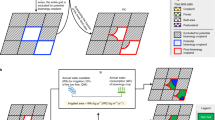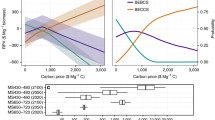Abstract
The paper estimates the potential contribution of Miscanthus × giganteus (Miscanthus) and short rotation coppice (SRC; in Great Britain often willow and poplar species, e.g. Salix. viminalis L. x S. viminalis var Joruun) to the heat and electricity needs in Great Britain to 2050 under climate change, using a model system which is composed of a partial equilibrium model and two process-based terrestrial biogeochemistry models. If the whole available area of land suitable for Miscanthus and SRC of 8 Mha is considered, results show that the contribution of Miscanthus and SRC to the heat and electricity supply would be significant. Under the projected climate and an imposed energy policy to 2050, the potential contribution would range from 139, 291 GWh to 230, 605 GWh for heat and from 112, 481 GWh to 127, 868 GWh for electricity by 2050. This would provide over 60 % of total heat and electricity needs in Great Britain. Using realistic implementation scenarios on just 0.4 Mha of land, Miscanthus and SRC could still contribute more than 5 % of heat and electricity needs in Great Britain. We conclude that Miscanthus and SRC have the potential to form part of a diverse renewable energy portfolio for Great Britain. In addition to climate and energy policy, the contribution of Miscanthus and SRC to heat and electricity will be impacted by the efficiency of combined heat and power (CHP) and alternative energy crops, and the area of land eventually used for dedicated bioenergy crops.

Similar content being viewed by others
References
Andersen RS, Towers W, Smith P (2005) Assessing the potential for biomass energy to contribute to Scotland’s renewable energy needs. Biomass Bioenergy 29:73–82
Aylott M, Casella E, Tubby I, Street NR, Smith P, Taylor G (2008) Yield and spatial supply of bioenergy poplar and willow short-rotation coppice in the UK. New Phytol 178:358–370
Bauen AW, Dunnett AJ, Richter GM, Dailey AG, Aylott M, Casella E, Taylor G (2010) Modelling supply and demand of bioenergy from short rotation coppice and Miscanthus in the UK. Bioresour Technol 101:8132–8143
Bellarby J, Wattenbach M, Tuck G, Glendining MJ, Smith P (2010) The potential distribution of bioenergy crops in the UK under present and future climate. Biomass Bioenergy 34:1935–1945
BERR (The UK Department for Business, Enterprise and Regulator Reform) (2008). UK Renewable Energy Strategy-consultation. http://webarchive.nationalarchives.gov.uk/+/http://www.berr.gov.uk/files/file46799.pdf. Accessed on 06 Sep 2012
Nakicenovic N, Alcamo J, Davis G, de Vries B, Fenhann J, Gaffin S et al (2000) Special report on emission scenarios. Cambridge University Press, Cambridge
Clarke D, Jablonski S, Moran B, Anandarajah G, Taylor G (2009) How can accelerated development of bioenergy contribute to the future UK energy mix? Insights from a MARKAL modelling exercise. Biotechnol Biofuels 2:13
DECC (The UK Department of Energy and Climate Change) (2012). http://www.decc.gov.uk/en/content/cms/meeting_energy/chp/chp.aspx. Accessed on 16 Oct 2012
DECC (The UK Department of Energy and Climate Change) (2011). http://chp.decc.gov.uk/app/reporting/index/viewtable/token/2. Accessed on 13 May 2011
DEFRA (The UK Department for Environment, Food and Rural Affairs) (2007). UK Biomass Strategy. http://www.biomassenergycentre.org.uk/pls/portal/docs/PAGE/RESOURCES/REF_LIB_RES/PUBLICATIONS/UKBIOMASSSTRATEGY.PDF. Accessed on 09 Nov 2012
DTI (The UK Department of Trade and Industry). (2006). The energy challenge-energy review report 2006. http://webarchive.nationalarchives.gov.uk/+/http://www.berr.gov.uk/files/file31890.pdf
DTI (The UK Department of Trade and Industry). (2007). Meeting the Energy Challenge – A White Paper on Energy May 2007. http://www.decc.gov.uk/en/content/cms/legislation/white_papers/white_paper_07/white_paper_07.aspx. Accessed on 19 July 2011
DS4DS (2013). Project website http://www.ds4ds.org
FAO/IIASA/ISRIC/ISSCAS/JRC. (2012). Harmonized World Soil Database (version 1.2). http://webarchive.iiasa.ac.at/Research/LUC/External-World-soil-database/HTML. Accessed on 13 Jun 2012
Hastings A, Clifton-Brown JC, Wattenbach M, Mitchell CP, Smith P (2009) The development of MISCANFOR, a new Miscanthus crop growth model: towards more robust yield predictions under different climatic and soil conditions. Glob Chang Biol-Bioenergy 1:154–170
Hastings A, Clifton-Brown JC, Wattenbach M, Mitchell CP, Stampfl P, Smith P (2009) Future energy potential of Miscanthus in Europe. Glob Chang Biol-Bioenergy 2:180–196
Hastings A, Tallis MJ, Casella E, Matthews RW, Henshall PA, Milner S, Smith P, Talyor G (2014) The technical potential of Great Britain to produce ligno-cellulosic biomass for bioenergy in current and future climates. Glob Chang Biol-Bioenergy. doi:10.1111/gcbb.12103
Khanna M, Dhungana B, Clifton-Brown J (2008) Costs of producing miscanthus and switchgrass for bioenergy in Illinois. Biomass Bioenergy 32:482–493
Lovett A, Sunnenberg G, Dockerty TL (2014) The availability of land for perennial energy crops in Great Britain. Glob Chang Biol-Bioenergy. doi:10.1111/gcbb.12147
Murphy J, Sexton D, Jenkins G, Boorman P, Booth B, Brown K, Clark R, Collins M, Harris G, Kendon L (2009) UK climate projections science report: climate change projections. Meteorological Office Hadley Centre, Exeter, UK
Smith P, Gregory P, van Vuuren D, Obersteiner M, Rounsevell M, Woods J, Havlik P, Stehfest E, Bellarby J (2010) Competition for land. Philos Trans R Soc B 365:2941–2957
St. Clair S, Hillier J, Smith P (2008) Estimating the pre-harvest greenhouse gas costs of energy crop production. Biomass Bioenergy 32:442–452
Tallis MJ, Casella E, Henshall PA, Aylott MJ, Randle TJ, Morison JIL, Taylor G (2013) Development and evaluation of ForestGrowth-SRC a process-based model for short rotation coppice yield and spatial supply reveals poplar uses water more efficiently than willow. Glob Chang Biol-Bioenergy 5:53–66
Taylor S, Firth S, Wang C, Allinson D, Quddus M, Smith P (2014) Spatial mapping of current and future building energy demand for matching to bioenergy supply in Great Britain. Glob Chang Biol-Bioenergy. doi:10.1111/gcbb.12165
Tuck G, Glendining MJ, Smith P, House JI, Wattenbach M (2006) The potential distribution of bioenergy crops in Europe under present and future climate. Biomass Bioenergy 30:183–197
UKERC (2013a). Energy data centre. http://ukedc.rl.ac.uk/
UKERC (2013b). The UK energy system in 2050: comparing low-carbon, resilient scenarios. Available at: http://www.ukerc.ac.uk/support/tiki-download_file.php?fileId=2976 (Accessed 10 Nov 2013)
Valentine J, Clifton-Brown J, Hastings A, Robson P, Allison G, Smith P (2012) Food vs. fuel: the use of land for lignocellulosic ‘next generation’ energy crops that minimise competition with primary food production. Glob Chang Biol-Bioenergy 4:1–19
Wang SF, Wang SC, Hastings A, Pogson M, Smith P (2012) Economic and greenhouse gas costs of Miscanthus supply chains in the United Kingdom. Glob Chang Biol-Bioenergy 4:358–363
Wang SF, Hastings A, Smith P (2012) An optimization model for energy crop supply. Glob Chang Biol-Bioenergy 4:88–95
Wang S, Hastings A, Wang SC, Sunnenberg G, Tallis MJ, Casella E, Taylor S, Wang C, Alexander P, Cisowska I, Lovett A, Taylor G, Firth S, Finch J, Moran D, Morison J, Smith P (2014) The potential for bioenergy crops to contribute to meeting GB heat and electricity demands. Glob Chang Biol-Bioenergy. doi:10.1111/gcbb.12123
Acknowledgments
This research formed part of the programme of the UK Energy Research Centre (UKERC) and was supported by the UK Research Councils under Natural Environment Research Council award: “Spatial Mapping and Evaluation of Energy Crop Distribution in Great Britain to 2050” (NE/H013415/1). We would like to thank Astley Hastings and Eric Casella for providing data and their useful help. PS is a Royal Society-Wolfson Research Merit Award holder.
Author information
Authors and Affiliations
Corresponding author
Electronic Supplementary Material
Below is the link to the electronic supplementary material.
ESM 1
(DOCX 20 kb)
Rights and permissions
About this article
Cite this article
Wang, S., Wang, S., Lovett, A. et al. Significant Contribution of Energy Crops to Heat and Electricity Needs in Great Britain to 2050. Bioenerg. Res. 7, 919–926 (2014). https://doi.org/10.1007/s12155-014-9422-z
Published:
Issue Date:
DOI: https://doi.org/10.1007/s12155-014-9422-z




